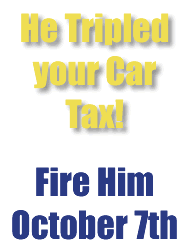 |
 -0 |
 |
|
|
||||||||
 |
||||||||
|
Recall backers see fishhook win California's interior, a burgeoning suburban mecca of freeway commuters -- many of whom work near the coast but opt not to live there -- will in the next 72 days be narrowly targeted with a sophisticated advertising blitz heavily dependent on cable television and direct mail, as recall proponents go straight to the source of voter discontent in their attempt to dump Davis. "The demographic is, from our standpoint, a perfect target for where the voter anger really is," said Dave Gilliard, chief political strategist for Rescue California. On Friday, one day after Lt. Gov. Cruz Bustamante designated Oct. 7 as the date of California's first ever gubernatorial recall election, Gilliard, in a lengthy interview, discussed Rescue California's plan to ensure Davis loses what he calls the most important question on the two-part recall ballot: "Shall Gray Davis be recalled as governor?" Gilliard's secret weapon is California's fishhook. Beginning on a map in the north with Greater Sacramento and lining south through the Central Valley, it then curves through Southern California's Inland Empire and Orange and San Diego counties. Why the fishhook? Because voters there accounted for more than 760,000 of the 1.4 million valid signatures submitted in favor of recalling Davis, and will likely be more than willing to yank him out of office, Gilliard said. "The Inland Empire and the Central Valley in particular offer affordable housing, and new homeowners tend to become more conservative with their tax dollars regardless of political persuasion," Gilliard said. San Bernardino and Riverside counties contributed more than 12 percent of all valid signatures -- or 165,664 -- and featured a signee-to-registered voter ratio of 13.6 percent. Orange and San Diego counties submitted 370,702 good signatures, and the counties of Placer, Sacramento, San Joaquin, Stanislaus, Fresno and Kern contributed 224,335. Gilliard said the middle-class families who live here are more likely to revolt against the Davis administration's tripling of vehicle registration fees -- derided as the car tax -- and be disgusted with the state's projected $38.2 billion deficit, red ink they could never get away with in their own checkbooks. GOP candidates who do not understand this and concentrate their time and advertising on network television in the mass markets and liberal-leaning regions of Greater Los Angeles and the San Francisco Bay area, will be making a huge mistake, albeit one that Republicans have made before. "Too many candidates do this, and it's a completely wrong way of running campaigns in California," Gilliard said, adding "This is not going to be the Bill Simon campaign, this is not going to be the Dan Lundgren campaign; we are committed to not falling into some of the same traps." Davis beat then-Attorney General Lundgren in a landslide in 1998, and Simon, a Republican businessman from Los Angeles, lost last year even though a majority of Californians at the time believed the state was headed in the wrong direction. A major part of the governor's successful campaign strategy was painting Lundgren and Simon as too conservative on social issues like abortion and gun control. But that strategy will go only so far this time because the second-term governor is also running against himself -- and Rescue California. "The only guy who has to get 50 percent of the vote to be governor is Gray Davis. He didn't get it last time," Gilliard said. Davis was re-elected just last November, beating Simon 47.3 percent to 42.4 percent. |
|
|
